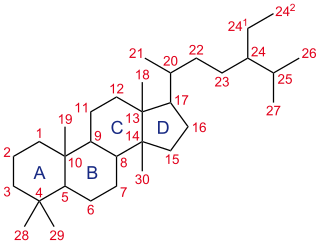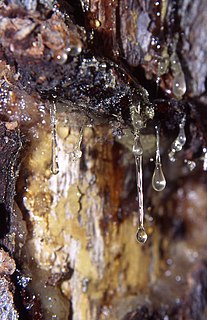
Histidine (symbol His or H) is an α-amino acid that is used in the biosynthesis of proteins. It contains an α-amino group (which is in the protonated –NH3+ form under biological conditions), a carboxylic acid group (which is in the deprotonated –COO− form under biological conditions), and an imidazole side chain (which is partially protonated), classifying it as a positively charged amino acid at physiological pH. Initially thought essential only for infants, it has now been shown in longer-term studies to be essential for adults also. It is encoded by the codons CAU and CAC.

A steroid is a biologically active organic compound with four rings arranged in a specific molecular configuration. Steroids have two principal biological functions: as important components of cell membranes which alter membrane fluidity; and as signaling molecules. Hundreds of steroids are found in plants, animals and fungi. All steroids are manufactured in cells from the sterols lanosterol (opisthokonts) or cycloartenol (plants). Lanosterol and cycloartenol are derived from the cyclization of the triterpene squalene.

The terpenoids, sometimes called isoprenoids, are a large and diverse class of naturally occurring organic chemicals derived from the 5-carbon compound isoprene, and the isoprene polymers called terpenes. Most are multicyclic structures with oxygen-containing functional groups. About 60% of known natural products are terpenoids. Although sometimes used interchangeably with "terpenes", terpenoids contain additional functional groups, usually O-containing. Terpenes are hydrocarbons.

Terpenes are a class of natural products consisting of compounds with the formula (C5H8)n. Comprising more than 30,000 compounds, these unsaturated hydrocarbons are produced predominantly by plants, particularly conifers. Terpenes are further classified by the number of carbons: monoterpenes (C10), sesquiterpenes (C15), diterpenes (C20), etc. A well known monoterpene is alpha-pinene, a major component of turpentine.

Ginkgolides are biologically active terpenic lactones present in Ginkgo biloba. They are diterpenoids with 20-carbon skeletons, which are biosynthesized from geranylgeranyl pyrophosphate.
Diterpenes are a class of chemical compounds composed of four isoprene units, often with the molecular formula C20H32. Diterpenes consist of four isoprene subunits. They are biosynthesized by plants, animals and fungi via the HMG-CoA reductase pathway, with geranylgeranyl pyrophosphate being a primary intermediate. Diterpenes form the basis for biologically important compounds such as retinol, retinal, and phytol. They are known to be antimicrobial and antiinflammatory.

Forskolin (coleonol) is a labdane diterpene that is produced by the Indian Coleus plant. Other names include pashanabhedi, Indian coleus, makandi, HL-362, mao hou qiao rui hua. As with other members of the large diterpene family of natural products, forskolin is derived from geranylgeranyl pyrophosphate (GGPP). Forskolin contains some unique functional elements, including the presence of a tetrahydropyran-derived heterocyclic ring. Forskolin is a commonly used material in laboratory research to increase levels of cyclic AMP by stimulation of adenylate cyclase.
Oxetane, or 1,3-propylene oxide, is a heterocyclic organic compound with the molecular formula C
3H
6O, having a four-membered ring with three carbon atoms and one oxygen atom.

Hopanoids are a diverse subclass of triterpenoids with the same hydrocarbon skeleton as the compound hopane. This group of pentacyclic molecules therefore refers to simple hopenes, hopanols and hopanes, but also to extensively functionalized derivatives such as bacteriohopanepolyols (BHPs) and hopanoids covalently attached to lipid A.

Caryophyllene, more formally (−)-β-caryophyllene, is a natural bicyclic sesquiterpene that is a constituent of many essential oils, especially clove oil, the oil from the stems and flowers of Syzygium aromaticum (cloves), the essential oil of Cannabis sativa, rosemary, and hops. It is usually found as a mixture with isocaryophyllene and α-humulene, a ring-opened isomer. Caryophyllene is notable for having a cyclobutane ring, as well as a trans-double bond in a 9-membered ring, both rarities in nature.

Sesquiterpenes are a class of terpenes that consist of three isoprene units and often have the molecular formula C15H24. Like monoterpenes, sesquiterpenes may be acyclic or contain rings, including many unique combinations. Biochemical modifications such as oxidation or rearrangement produce the related sesquiterpenoids.
Monoterpenes are a class of terpenes that consist of two isoprene units and have the molecular formula C10H16. Monoterpenes may be linear (acyclic) or contain rings (monocyclic and bicyclic). Modified terpenes, such as those containing oxygen functionality or missing a methyl group, are called monoterpenoids. Monoterpenes and monoterpenoids are diverse. They have relevance to the pharmaceutical, cosmetic, agricultural, and food industries.

Steviol glycosides are the chemical compounds responsible for the sweet taste of the leaves of the South American plant Stevia rebaudiana (Asteraceae) and the main ingredients of many sweeteners marketed under the generic name stevia and several trade names. They also occur in the related species Stevia phlebophylla and in the plant Rubus chingii (Rosaceae).

Andrographolide is a labdane diterpenoid that has been isolated from the stem and leaves of Andrographis paniculata. Andrographolide is an extremely bitter substance.
Clerodane diterpenes, sometimes referred to as clerodane diterpenoids, are a large group of secondary metabolites that have been isolated from several hundreds of different plant species, as well as fungi, bacteria and marine sponges. They are bicyclic terpenes that contain 20 carbons and a decalin core.

Levopimaric acid is an abietane-type of diterpene resin acid. It is a major constituent of pine oleoresin with the chemical formula of C20H30O2. In general, the abietene types of diterpene resin acid have various biological activities, such as antibacterial, cardiovascular and antioxidant. About 18 to 25% of levopimaric acid is found in pine oleoresin. The production of oleoresin by conifer species is an important component of the defense response against insect attack and fungal pathogen infection.

Gersemia rubiformis, commonly known as the sea strawberry, is a species of soft coral in the family Nephtheidae. It is found in the northwest Atlantic and the northeast Pacific Oceans.

Elymoclavine is an ergot alkaloid. It can be produced from C. fusiformis from Pennisetum typhoideum. It is a precursor in the biosynthesis of D-(+)-lysergic acid. Ergot alkaloids are natural products derived from L-tryptophan. They are often toxic for humans and animals. Despite that they are also well known for their pharmacological activities.

Pseudopterosin A is a diterpene glycoside isolated from the gorgonian sea whip Pseudopterogorgia elisabethae, found in the Bahamas and Florida Keys. Pseudopterosins A-D, which differ in the degree of acetylation at the sugar ring, were first isolated and reported in 1986. There are at least 25 unique diterpenes isolated from this species of marine animal. Samples of P. elisabethae from the Bahamas are found to have higher concentrations of pseudopterosins than populations from the Florida Keys, which have a greater diversity in diterpene structures.

β-Araneosene is a molecule first isolated in 1975 from the mold Sordaria araneosa by Borschberg. This unprecedented diterpene framework was given the name “araneosene”. In 1976, the skeletal class was renamed to “dolabellane” due to the isolation of several compounds containing this framework found from the sea hare Dolabella californica. Since their initial discovery, there are now more than 150 known dolabellanes, mostly isolated from marine sources.

















